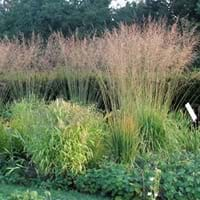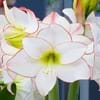Life Span
Perennial
Perennial
Type
Bulb or Corm or Tuber
Grass
Origin
Hybrid origin
Europe, Eastern Europe, Southern Europe, Russia/Siberia, Asia, Central Asia, Southern Asia
Types
Not Available
Not Available
Habitat
tropical environments
Boggy areas, Dry and Young forest Heaths, Lowland
USDA Hardiness Zone
8-11
5-8
AHS Heat Zone
Not Available
9 - 1
Sunset Zone
21,22
1a, 1b, 2a, 2b, 3a, 3b, 4, 5, 6, 7, 8, 9, 14, 15, 16, 17
Habit
Clump-Forming
Arching/Fountain-shaped
Flower Color
White, Red, Light Pink
Dark Purple
Flower Color Modifier
Bicolor
Bicolor
Fruit Color
Green, Brown
Non Fruiting Plant
Leaf Color in Spring
Green, Dark Green
Green
Leaf Color in Summer
Light Green
Light Green
Leaf Color in Fall
Several shades of Green
Green, Gold
Leaf Color in Winter
Light Green
Tan
Leaf Shape
Long Linear
Needle like
Plant Season
Spring, Summer, Winter
Spring, Summer, Fall, Winter
Sunlight
Full Sun, Partial Sun
Partial Sun, Partial shade
Type of Soil
Loam, Sand
Clay, Loam, Sand
The pH of Soil
Acidic, Neutral
Acidic, Neutral
Soil Drainage
Well drained
Average
Bloom Time
Not Available
Early Summer, Summer, Late Summer, Early Fall
Tolerances
Deer resistant
Not Available
Where to Plant?
Container, Ground, Pot
Ground, Pot
How to Plant?
Divison, From Rhizomes, Tubers
Divison, Transplanting, Vegetative Reproduction
Plant Maintenance
Low
Low
Watering Requirements
Average Water Needs
Requires regular watering, Water more frequently during periods of extreme drought
In Summer
Lots of watering
Lots of watering
In Spring
Moderate
Moderate
In Winter
Average Water
Average Water
Soil pH
Acidic, Neutral
Acidic, Neutral
Soil Type
Loam, Sand
Clay, Loam, Sand
Soil Drainage Capacity
Well drained
Average
Sun Exposure
Full Sun, Partial Sun
Partial Sun, Partial shade
Pruning
Cut or pinch the stems, Remove damaged leaves, Remove dead branches, Remove dead leaves
Prune in winter, Remove damaged leaves, Remove dead branches, Remove dead leaves
Fertilizers
as it is a flowering plant, use high phosphorous content fertilizer, Nitrogen, Phosphorous, Potassium, Requires high amount of nitrogen
No need to fertilize every year
Pests and Diseases
Aphids, Grasshoppers, Mealybugs, Mites, Red blotch, Slugs, Snails
Pests and diseases free
Plant Tolerance
Deer resistant
Not Available
Flower Petal Number
Not Available
Single
Edible Fruit
Not Available
No
Fragrant Flower
Not Available
No
Foliage Texture
Medium
Medium
Foliage Sheen
Glossy
Matte
Attracts
Bees, Butterflies, Hummingbirds
Not Available
Allergy
poisonous if ingested
Not Available
Aesthetic Uses
Beautification, Bouquets, Cottage Garden, Showy Purposes
Showy Purposes, Water gardening
Beauty Benefits
Not Available
Not Available
Environmental Uses
Not Available
No fertilizer, pesticides, or herbicides needed
Medicinal Uses
Not Available
No Medicinal Use
Part of Plant Used
Flowers
Whole plant
Other Uses
Used as Ornamental plant, Used for bedding in gardens
Used as Ornamental plant
Used As Indoor Plant
Yes
No
Used As Outdoor Plant
Yes
Yes
Garden Design
Container, Cutflower, Houseplant, Mixed Border, Tropical
Bedding Plant, Container, Cutflower, Dried Flower/Everlasting, Mixed Border
Botanical Name
HIPPEASTRUM 'Picotee'
Molinia arundinacea
Common Name
Florist Amaryllis, Hippeastrum, Picotee Hippeastrum
Moor Grass
In Hindi
HIPPEASTRUM
Tall Moor Grass
In German
HIPPEASTRUM
Hoch Pfeifengras
In French
HIPPEASTRUM
Herbe Moor hauteur
In Spanish
Hippeastrum
Tall Grass Moor
In Greek
Hippeastrum
Ψηλός Moor Grass
In Portuguese
HIPPEASTRUM
Alto Moor Relva
In Polish
Hippeastrum
Wysoki Moor Trawa
In Latin
Hippeastrum
Alta Maurus Grass
Phylum
Magnoliophyta
Magnoliophyta
Class
Magnoliopsida
Liliopsida
Order
Asparagales
Cyperales
Family
Amaryllidaceae
Poaceae
Clade
Angiosperms, Monocots
Angiosperms, Commelinids, Monocots
Tribe
Not Available
Not Available
Subfamily
Amaryllidoideae
Not Available
Number of Species
Not Available
Season and Care of Hippeastrum and Molinia Arundinacea
Season and care of Hippeastrum and Molinia Arundinacea is important to know. While considering everything about Hippeastrum and Molinia Arundinacea Care, growing season is an essential factor. Hippeastrum season is Spring, Summer and Winter and Molinia Arundinacea season is Spring, Summer and Winter. The type of soil for Hippeastrum is Loam, Sand and for Molinia Arundinacea is Clay, Loam, Sand while the PH of soil for Hippeastrum is Acidic, Neutral and for Molinia Arundinacea is Acidic, Neutral.
Hippeastrum and Molinia Arundinacea Physical Information
Hippeastrum and Molinia Arundinacea physical information is very important for comparison. Hippeastrum height is 38.10 cm and width 30.10 cm whereas Molinia Arundinacea height is 90.00 cm and width 15.20 cm. The color specification of Hippeastrum and Molinia Arundinacea are as follows:
Hippeastrum flower color: White, Red and Light Pink
Hippeastrum leaf color: Green and Dark Green
Molinia Arundinacea flower color: Dark Purple
- Molinia Arundinacea leaf color: Green
Care of Hippeastrum and Molinia Arundinacea
Care of Hippeastrum and Molinia Arundinacea include pruning, fertilizers, watering etc. Hippeastrum pruning is done Cut or pinch the stems, Remove damaged leaves, Remove dead branches and Remove dead leaves and Molinia Arundinacea pruning is done Prune in winter, Remove damaged leaves, Remove dead branches and Remove dead leaves. In summer Hippeastrum needs Lots of watering and in winter, it needs Average Water. Whereas, in summer Molinia Arundinacea needs Lots of watering and in winter, it needs Average Water.





